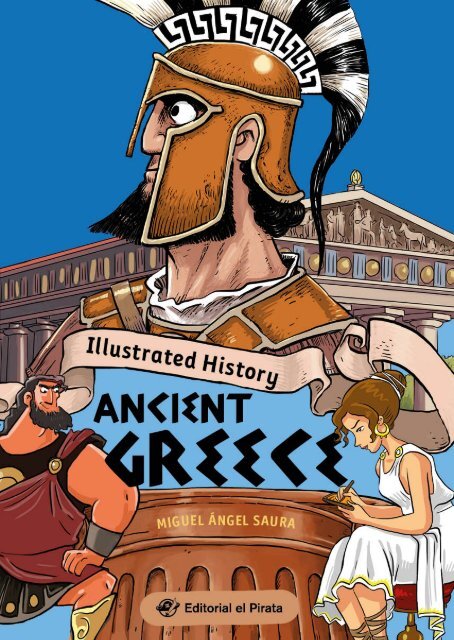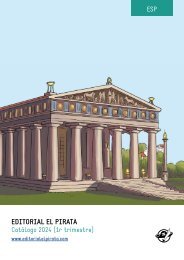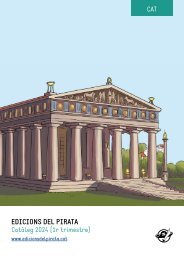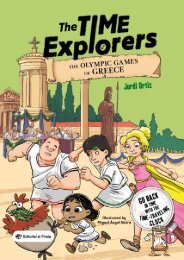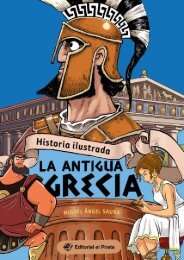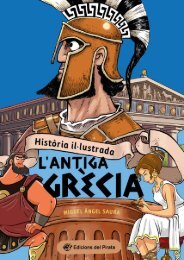Ilustrated History- Ancient Greece
- No tags were found...
Create successful ePaper yourself
Turn your PDF publications into a flip-book with our unique Google optimized e-Paper software.
ANCIENT<br />
GREECE<br />
Miguel Ángel Saura
KEY POINTS IN THE HISTORY<br />
OF ANCIENT GREECE<br />
3400 BC<br />
Birth of the<br />
Minoan civilization<br />
17th-11th centuries BC<br />
Mycenae and the<br />
Dorian invasions<br />
Approximately<br />
13th century BC<br />
The Trojan War<br />
1st century BC-6th century AD<br />
The fall of Hellenism
12th-8th centuries BC<br />
The Dark Ages<br />
776 BC<br />
The first Olympic<br />
Games<br />
5th-4th centuries BC<br />
The Classical Period<br />
4th-1st centuries BC<br />
The Hellenistic Period<br />
5th century BC<br />
The Greco-Persian Wars
4<br />
CONTENTS<br />
WHO WERE THE GREEKS?<br />
The Minoan Civilization<br />
Mycenae<br />
The Dorian Invasions<br />
THE DARK AGES<br />
The Trojan War<br />
THE ARCHAIC PERIOD<br />
The Poleis<br />
The Colonies<br />
Politics<br />
Society<br />
The Art of Warfare<br />
The Olympian Religion<br />
Lawgivers<br />
This Is Sparta<br />
The Age of Tyrants<br />
Democracy<br />
The Olympic Games<br />
5<br />
8<br />
12<br />
14<br />
17<br />
19<br />
23<br />
24<br />
26<br />
28<br />
30<br />
32<br />
34<br />
42<br />
44<br />
46<br />
52<br />
54<br />
THE CLASSICAL PERIOD<br />
The Ionian Revolt<br />
The First Greco-Persian War<br />
The Second Greco-Persian War<br />
Artemisia of Caria<br />
Pericles and the Parthenon<br />
Sculpture<br />
Architecture<br />
The Theater<br />
Milo of Croton<br />
The Peloponnese War<br />
Socrates<br />
Thebes’ Time Comes: Epaminondas<br />
Macedonia’s Time Comes: Philip II<br />
Alexander the Great<br />
THE HELLENISTIC PERIOD<br />
A Man Named Ptolemy<br />
The Library of Alexandria<br />
Antigonus<br />
The End of the Hellenistic Period<br />
The Legacy of <strong>Greece</strong><br />
59<br />
60<br />
62<br />
68<br />
72<br />
74<br />
78<br />
80<br />
82<br />
84<br />
88<br />
92<br />
94<br />
96<br />
98<br />
103<br />
104<br />
106<br />
108<br />
110<br />
116
WHO WERE<br />
THE GREEKS?<br />
The history of the Greeks started very early. No sooner had<br />
the region emerged from prehistoric times than great civilizations<br />
evolved that knew about writing, created interesting<br />
works of art, and built impressive palaces. These cultures<br />
disappeared, swept away by invasions, in what is known as<br />
the Dark Ages.<br />
After this period of wars and destruction, Greek culture<br />
began to appear. This was the Archaic Period, which ended<br />
when the Greeks defeated the Persians. It was then that<br />
the Classical Period began, during which their civilization<br />
reached its full glory. This cultural golden age ended with<br />
Macedonia’s invasion of <strong>Greece</strong>. The Hellenistic Period was<br />
the age in which Greek culture expanded into Asia, and it<br />
ended with the Roman conquest of <strong>Greece</strong> and Macedonia,<br />
following which the Greeks became subjects of the Roman<br />
Empire.
6<br />
WHO WERE THE GREEKS?<br />
<strong>Greece</strong> is a small, mountainous country. Its rugged landscape<br />
and steep roads made overland communication very<br />
difficult. The Greeks never bothered to build good roads, and<br />
fertile, easily cultivated land was on the rare side. So, from<br />
the beginning, Greek cities depended on trade for survival.<br />
The mountainous terrain isolated the population, so that<br />
while they belonged to a single people, the Greeks of various<br />
regions were very different from each other. They could never<br />
agree for long enough to create empires as large as those of<br />
the Egyptians and Persians.<br />
However, the Greek coastline is dotted with beaches and<br />
natural harbors. In fact, almost every city was near the coast<br />
and had its own harbor. This meant that the Greeks, as a<br />
people, had a very close relationship with the sea.<br />
Greek merchants sailed all over the Mediterranean in<br />
search of buyers for their amphorae of oil and wine. When<br />
the ships returned from their voyages, they brought back to<br />
their cities Egyptian medicine, Persian science, and Phoenician<br />
navigation techniques, to name just a few examples.<br />
Their civilization was always open to new ideas, and they<br />
took art, culture, and science much further than any other<br />
people in the ancient world.
7<br />
MACEDONIA<br />
MOUNT<br />
OLYMPUS<br />
AEGEAN SEA<br />
THERMOPYLAE<br />
THEBES<br />
MARATHON<br />
CORINITH<br />
ATHENS<br />
OLYMPIA<br />
SALAMIS<br />
PERSIA<br />
IONIA<br />
SPARTA<br />
MEDITERRANEAN SEA<br />
CRETE
8<br />
THE MINOAN<br />
CIVILIZATION<br />
The first great culture of the area<br />
appeared on Crete, an island just<br />
south of <strong>Greece</strong>. It is known as the<br />
Minoan culture because its most<br />
legendary king was called Minos.<br />
It lasted from around 3400 to 1200<br />
BC.<br />
In those times, the Cretans dominated<br />
the Mediterranean thanks to<br />
a powerful war fleet that protected<br />
their merchant ships.<br />
When civilization began to<br />
develop on mainland <strong>Greece</strong>, the<br />
Greeks tried to imitate Minoan art<br />
and culture.<br />
The Cretans built impressive<br />
palaces of several stories high, with<br />
terraces and inner courtyards. The<br />
walls were decorated with paintings<br />
depicting the Cretan people<br />
enjoying an elegant and sophisticated<br />
way of life.<br />
No one knows when or why the<br />
Minoan civilization disappeared,<br />
but it may have been due to a<br />
series of natural disasters, such as<br />
earthquakes, volcano eruptions, or<br />
tsunamis, followed by an invasion.
YOU MAY NOT KNOW THAT…<br />
Bulls were sacred animals to the Minoans. They can be found<br />
everywhere on Cretan archeological sites: statuettes of bulls,<br />
medallions with bulls, sculptures of bulls... Even the Minoan<br />
city walls are decorated with horns. But the most spectacular<br />
representations are the wall paintings, which depict a<br />
curious ritual.<br />
The paintings show boys and girls jumping and dancing<br />
around these animals. These rituals took place in the inner<br />
courtyards of the palaces, some of which were up to four<br />
stories high. Crete’s magnificent palaces, as seen through<br />
the eyes of the much more primitive Greeks of the time, were<br />
probably the origin of the legend of the Minotaur’s labyrinth.<br />
9
10<br />
THE MINOAN<br />
CIVILIZATION<br />
The Minotaur<br />
Legend has it that the king of<br />
Crete, Minos, was unable to<br />
have children and asked the<br />
gods for help. The god of the<br />
sea, Poseidon, sent him a magnificent<br />
white bull to sacrifice<br />
in his honor, but Minos kept<br />
the bull and sacrificed another<br />
animal instead. When Poseidon<br />
realized, he was very angry and<br />
made Pasiphae, the King’s wife,<br />
fall in love with the bull. A few<br />
months later, the queen gave birth to a monstrous baby, halfman<br />
and half-bull: the Minotaur.<br />
The child grew up to become a cruel, savage being that<br />
fed on people. Horrified, Minos ordered the famous architect<br />
Daedalus to design a place to imprison the monster—a construction<br />
so complex that it was impossible to get out once<br />
you had gone in. They called it a labyrinth.<br />
Then war broke out between the Greek city of Athens and<br />
the Cretans, led by Minos. Crete won the war, and Minos<br />
demanded a terrible condition in exchange for peace: Every<br />
year, Athens would send ten boys and ten girls to Crete to be<br />
devoured by the Minotaur.<br />
The king of <strong>Greece</strong>’s son, Theseus, volunteered to<br />
kill the monster. Minos’ daughter, Ariadne, fell<br />
in love with Theseus and gave him two gifts:
11<br />
a sword so he could defend himself against the monster and<br />
a spool of yarn to tie at the entrance and unwind as he went<br />
deeper into the labyrinth. So, after slaying the Minotaur,<br />
Theseus was able to find his way back thanks to Ariadne’s<br />
thread and return to Athens victorious.<br />
The Flight of Icarus<br />
When the labyrinth was finished, Daedalus sent the bill to<br />
King Minos. When the king saw the price, he decided to save<br />
the money by enclosing Daedalus and his son, Icarus, in the<br />
labyrinth to be the Minotaur's dinner.<br />
Daedalus, lost in the prison that he himself had built,<br />
found an old eagle’s nest full of feathers. He made wings out<br />
of them, using beeswax to attach the feathers to a wooden<br />
structure that he invented. When the two sets of wings were<br />
ready, father and son left the labyrinth by air, and they flew<br />
off home over the sea. Before they set off, Daedalus warned<br />
his son not to fly too high, but Icarus didn't listen to his<br />
father; he was too enthusiastic about flying. He flew so high<br />
that the heat of the sun melted the wax, and the feathers<br />
came unstuck, causing Icarus to fall into the sea and drown.
12<br />
MYCENAE<br />
By the time Minoan culture had disappeared,<br />
a new civilization was emerging in mainland<br />
<strong>Greece</strong>: the Mycenean civilization, lasting<br />
from around 1700 to 1050 BC. These were no<br />
longer primitive peoples but complete societies<br />
with palaces and fortresses that dominated<br />
large regions. The entire country was divided<br />
up into small kingdoms which were all at war<br />
with each other, each led by a<br />
king and a group of elite warriors<br />
with weapons made of bronze.<br />
Peasants and slaves cultivated<br />
the land. The crops were stored in huge,<br />
fortified palaces where the king and the<br />
nobles lived. These palaces had mighty walls,<br />
storerooms, and houses that were several<br />
stories high.<br />
Mycenaean culture was strongly influenced<br />
by Minoan culture. Some experts believe that the Mycenaean<br />
warriors had something to do with the demise of Minoan<br />
civilization. The Mycenaeans may have taken advantage of<br />
a natural disaster to attack the Cretan<br />
cities, which didn't have city walls<br />
around them because they relied on<br />
their powerful battle fleet to protect<br />
them from invasion.
swords, chariots, and armor against<br />
sticks and stones. We rich folk really<br />
know how to do things.<br />
13<br />
Combat Chariots<br />
At that time, the hardest known material was bronze, a mixture<br />
of copper and tin. It’s a tough, resistant metal that is<br />
easy to shape. However, tin was very expensive and scarce,<br />
so only the really rich could afford the most sophisticated<br />
military equipment: bronze swords, shields, and amour, as<br />
well as war chariots pulled by a pair of horses.<br />
These chariots were the state-of-the-art technology of<br />
the time: fast and sturdy, they carried a two-man crew. One<br />
was the driver, who steered the horses against the enemy<br />
formation, and the other was the marksman, who threw<br />
arrows and javelins at the enemy and could run away quickly<br />
when they counter-attacked.


